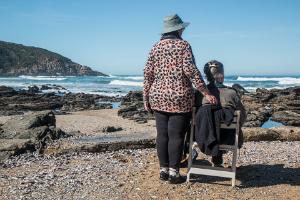Healthy ageing
Health inequalities of older people in coastal and rural areas

What is the evidence summary? A review of the available academic evidence supplemented with case studies on the health inequalities in older people (aged 50 years or older) in coastal and rural areas.
What is the main aim? To provide a summary of the health inequalities experienced by older people in coastal and rural areas, alongside ways to reduce inequalities and promote healthy ageing in these areas by taking an asset-based approach - placing people’s skills, networks and community resources (their assets) alongside their needs.
Why is this study important? Older people are a large and growing population in rural and coastal areas. The number of those aged 65-and-over is predicted to grow by around 50% in rural areas by 2039, with the ratio of older to younger people set to increase.
Age is a risk factor for loneliness and social isolation; those in rural or coastal areas may be at higher risk. However, there is little research evidence on inequality and social connections in later life. In general, older people have tended to be neglected in research on health inequalities compared with people in other stages of life.
A key gap was highlighted in applying knowledge and evidence on health inequalities for older people in coastal and rural areas of England. The review sought to increase the availability of evidence, and propose practical solutions for people working in the health and social care system to support and promote work on healthy ageing.
What are the outcomes? We included 111 articles, with most studies focused on rural rather than coastal areas. Overall studies showed that older people in rural areas were less likely to die (relative to the size and age of the population) but there was some evidence reporting that they had poorer physical and mental health in rural and coastal populations than in urban areas.
Neurological problems (such as cognitive decline and impairment) were associated with living in rural areas but there was a lack of evidence in relation to coastal areas.
Issues determining and driving inequalities were found to include social exclusion and isolation; lack of access to and awareness of services; lack of transport and distance from services; lack of physical activity; the same outcome costing more in rural areas (such as providing home care services); and workforce challenges facing services in rural areas. However, research showed that older people in rural and coastal areas possessed some key assets and sources of resilience which could help to reduce the existing inequalities.
There are a growing number of effective interventions aimed at reducing health inequalities for older people in rural and coastal areas including those making use of telehealth and other forms of digital technology. Digital interventions, which enhanced rather than replaced face-to-face care, were deemed most appropriate, such as an opportunity to attend clinic activities by videoconference.
Who conducted this research? The Chief Investigator is Dr Katie Haighton from Northumbria University.
When did the study take place? The study started in January 2019 and lasted four months.
Who funded this study? Public Health England.
For more information, please:
- Visit the PHE website to read the review documents
- Email: katie.haighton@northumbria.ac.uk
Last modified: Wed, 04 Sep 2019 12:09:44 BST





